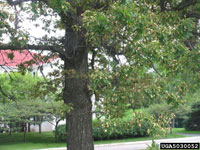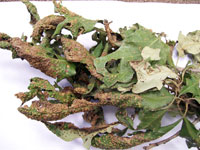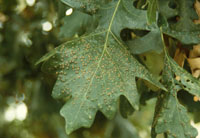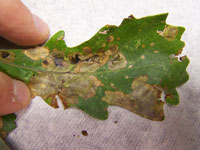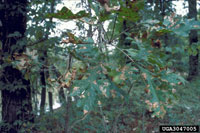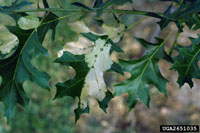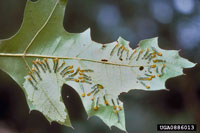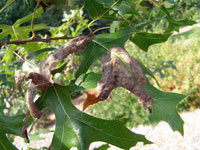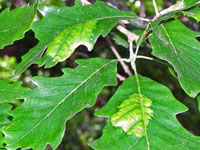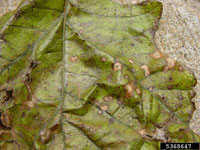Extension > Garden > Diagnose a problem > What's wrong with my plant? > Deciduous Trees > Oak > Brown spots or blotches on leaves
Oak > Leaves > Brown spots or blotches on leaves
1 of 7
Oak anthracnose
Discula quercina
- Leaves have scattered brown, irregular spots that can coalesce into nearly completely brown leaves
- Affected leaves become wrinkled, cupped or curled especially around leaf edges
- On severely infected trees, leaves fall off early in the season, trees soon sends out new leaves
- Damage is most common on lower and interior branches
- Damage most common in spring as leaves are growing during wet weather
- Most affected are trees within white oak group (white oak, bur oak, swamp white oak)
- More information on Oak anthracnose
2 of 7
Bur oak blight
Tubakia iowensis
- Infects only bur oaks - small acorn variety
- Spring and early summer, leaf veins on lower leaf surface have dark brown dots or short lines
- Mid-summer and fall, random lengths of leaf vein turn brown; some expand into brown wedge shaped areas on leaves
- Leaves may turn completely brown, some drop early
- Small raised black dots form on the petiole (stem) of infected leaves
- Some leaves remain attached through winter
- Symptoms appear in lower, inner canopy first. Disease progresses upward and outward over multiple seasons
- More information on Bur oak blight
3 of 7
Jumping oak gall wasp
Neuroterus saltatorius
- Leaf upper surface has brown spots, 1/16 to 1/8 inch diameter, encircled by yellow halo
- Growths the size of BBs or small seeds on leaf undersides
- Foliage can be discolored or turn brown when leaves heavily infested
- Can cause premature leaf loss
- Commonly associated with white oaks
- More information on Jumping oak gall wasp
4 of 7
Oak leaf miner
Cameraria spp.
- Larvae feed between leaf surfaces creating blotch-like mines
- Canopy looks brown when heavily infested; defoliation can occur
- Larvae 1/4 inch long with bodies that taper to rear, although larvae are rarely seen
- Primarily attacks white oak
5 of 7
Oak slug sawfly
Caliroa quercuscoccineae
- Larvae windowpane feed underside of leaf, i.e. chew leaf one layer of leaf tissue between the veins creating a lacelike appearance
- Larvae is dark green to black and covered in slime; adult is non-stinging wasp that is rarely seen
- Damage first visible early summer
- Pin oak and black oak are preferred hosts
- More information on Oak slug sawfly
6 of 7
Oak leaf blister
Taphrina caerulescens
- Raised blister-like leaf spots; appear sunken from the underside of the leaf
- Leaf blisters are initially pale green to orange, but turn brown with age
- Blister areas range from 1/16 to 1/2 inch in length
- Heavy infestation will cause leaf to curl after the blisters have merged together
- Leaves do not drop
- Damage most common in spring as leaves are growing during wet weather
- More information on Oak leaf blister
7 of 7
Tubakia leaf spot
Tubakia dryina
- ¼ to ½ inch sized leaf spots or blotches that are dark brown or reddish-brown
- Spots often restricted by leaf veins; defoliation occurs if infection is severe
- In severe cases, the canopy appears full of brown leaves
- Symptoms first present mid-summer but become most obvious late summer
- All oaks are susceptible
- More information on Tubakia leaf spot





